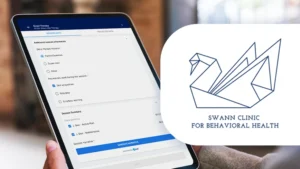ABA parent training is an important factor in improving treatment outcomes. Behavior analysts have a robust toolbox of skills and knowledge that help them promote skill acquisition and affect behavior change. Parents and caregivers, however, have one incredibly important tool not as readily available to a Board Certified Behavior Analyst (BCBA) - time. A learner’s parents have easy access to early morning mayhem, mid-day meltdowns, and bedtime blowouts in an organic way that isn’t always easy, or even possible, to replicate for professional service providers. Parents also cannot clock out! Because of the tools each party can bring to the table, a collaborative relationship between the behavior analyst and a learner’s parents can significantly improve treatment outcomes, particularly in areas that will lead to socially significant improvements in home and family life, which is why ABA parent training is so important.
ABA parent training has been shown to reduce parent stress, improve family interactions, and improve child treatment outcomes (Lesack et al., 2014; Masse, et al., 2016). Many funding sources, including major insurance coverage providers, make parent training a mandatory part of an applied behavior analysis (ABA) treatment plan (Tricare-West, n.d.). Further, parent training may be the only option of getting ‘services’ for some families due to lack of providers in the area or living in rural areas. As such, quality parent training that can be delivered remotely, when it is not feasible to provide in-person direct services, is critical.
Check out these 10 steps you can use to implement or refine an existing parent training program. Note, we use the term parent quite liberally in this blog, with an understanding that families look quite different from one family to the next. “Parent” used in this blog refers to any adult who is responsible for a household and for providing care for the family’s well-being (Hieneman, Fefer, Isley, & Sieders, 2022).
1. Take Inventory of the Family System
A family is a system (Kennedy, 2022). The learner with autism or IDD is just one part of an entire system that includes different people operating under different contingencies, which, at times, can compete with the learner’s progress. The clinician should evaluate all parts of the system to identify baseline levels of the system. Some areas to evaluate include the following:
- Who are the members of the family system, including caregivers that may not be “family” but are active like family?
- Do co-parents have alignment across values and goals?
- How much bandwidth do these members have? Are there competing contingencies?
- Are the basic needs of the whole family being met? The learner specifically? Are there any threats to these basic needs?
- Is there a need for other services (e.g., social worker, respite, etc.)? Are they receiving other services?
- Is the child loved and respected across all environments?

2. Assess Skill Level
The first step in the treatment of any client is assessing their current skill levels. In the case of parent training, it is the parent we are assessing. While the content in parent training may primarily include training in ABA techniques, there are also some other skills to assess that will bolster your parent training work. Depending on the results of Step 1, you may have to work on basic parenting strategies (e.g., follow through, active listening, making time). Further, including content about how to advocate for your child (or teaching them how to advocate for themselves) and identifying parenting values will be critically important when implementing meaningful treatment. Some areas to assess include the following:
- What skills and knowledge do they already have?
- Are they new to ABA techniques or has their child been receiving services for a while?
- What concepts would be helpful for them to understand?
- Are there specific skills like reinforcement delivery or collecting ABC related to their child's ABA program from which they would benefit?
- How do they react when their child acts out or engages in unwanted behavior?
- Is there a person who knows how to advocate for the rights of the individual with autism or IDD within the family system?
Once you have an idea of what the initial needs are, consider skills and concepts may need to be taught to address the parents’ needs. Even if they understand something general, such as reinforcement, it may be good to review it together to ensure everyone is on the same page.
3. Look for Barriers
The most robust, technical, and intensive behavior intervention plan will be unsuccessful if the people responsible for the day-to-day implementation don’t have the capacity or resources for its execution. Parents of children with disabilities, particularly autism spectrum disorder or behavioral disorders, often “hang on by a thread.” You may be working with a parent who has not dared leave the house with their child in years. A successful plan is one that has considered the barriers to parents’ successful implementation and attempts to mitigate those barriers or build accommodations to those barriers.
Here are some things to consider as you look for possible barriers:
- Socioeconomic status
- Cultural values
- Employment considerations
- Additional support systems (extended family, religious or cultural groups)
- Education level of parents
- Primary language
- Responses to feedback
- Multiple children (with or without disabilities)
- Access and familiarity to technology
Keep possible barriers in mind, even when creating and delivering parent training remotely. Videos (and video modeling) may be more accessible to parents than written directions. CentralReach’s Avail is an easy-to-use tool that parents can use to watch models of skills they are to use with their children.

4. Define Success
As you get to know the family and their needs, a critical piece of your assessment is to learn what success means for them. As a clinician, you may see things from a particular lens – this lens has bias no matter how much you try to eliminate it. Specifically asking each member of the family system what success looks like to them will help inform you of their goals and expectations, with a sneak peek into their values. For example, parent 1 may list “potty training” as a measure of success, where parent 2 may just say “I want my child to be happy.” The sibling could say “I want them to play with me” and everyone involved would say “but we really need him to stop banging on the walls or else we will get kicked out of our apartment again.” Finally, your observation of the learner is that they are very much into video games and bang in frustration when they lose. This information helps you identify what is important to everyone in the family, and what needs to be addressed with immediacy versus what might be long-term objectives.
5. Design a Plan
Following a holistic assessment of the family as a system and identifying barriers to a successful intervention, the clinician should craft a plan that is individualized to the family. This plan takes in account all participants of the family system: parents, siblings, active caretakers (grandparents, aunts/uncles, nannies, neighbors), etc. It should either create accommodations to mitigate the barriers to success (e.g., only work on 1 goal at a time if bandwidth is an issue) or a solution to solve for barriers (e.g., assign bilingual therapists to case to communicate with grandparents).
6. Make a Commitment
The BACB ethical code outlines the commitment we provide to those we serve through not accepting clients if we cannot provide them with the time commitment they deserve. But hearing that commitment from you may be valuable to the family since you will likely be asking them to do hard things, or at least things they are not used to. This step to make a commitment is when you, as the clinician, make a commitment to the family about how you will show up, what you will provide, how often you will be available, the best ways to contact you, etc.
Further, it is a time for you to ask a commitment of the family: are they willing to attend meetings at an agreed upon schedule (who is to attend?), to complete mutually agreed upon assignments, what is the best way to contact them, etc. When all these things are addressed at the onset of the training relationship, and they are documented in a contracted form, you can refer to them if any member (including yourself) breaks that commitment. If needed, talk about what consequences will be in place if commitments are continually broken (e.g., reset priorities, shift expectations) – and what consequences will be in place if commitments are continually fulfilled (e.g., the grandma says she will make a special recipe if the family meets their commitments for 3 months).

7. Assign Parent Education
Parent training can occur in many ways, but it may be helpful to divide it up and think of two different facets of parent education - where a provider conveys information to parents through discussion, modeling, and examples and parent support in which a provider coaches parents in behavior skills training where specific behavior management skills are demonstrated and practiced to mastery.
Parent Education is a way to deliver concept instruction about higher-order concepts that are not necessarily practiced in-situ. Given one’s resources you can deliver this training in person individually or in a group format, or even asynchronously through a learning management system. Finding easy-to-use and attainable technology, for both the clinician and the parent, is key when wanting to deliver accessible trainings. While live trainings may be hard to schedule at times, it does provide the opportunity to immediately address questions as they arise.
It is important to consider how you can repurpose the training materials create for parent education for subsequent trainings and families. BCBA supervisors may save time by creating reusable resources for education, storing them in a centralized location (such as CentralReach’s file storage), and sharing them with parents via a client portal as part of the client intake process. Education and counseling may also be more easily implemented than behavior skills training for other support people who interact with the child - teachers, babysitters, grandparents, etc.
A few ideas of topics that lend themselves to education and counseling training include:
- Can’t do vs. Won’t do behaviors
- Identifying antecedents, behaviors, and consequences
- Principles of reinforcement
- Helpful visual supports
- All behavior is communication
- How to build a system of support
8. Assign Parent Support
While parent education and counseling are an important part of a parent training plan, parent support, or skills training, has been shown to achieve better results than parent education alone. Specifically, adding parent support increases parent engagement in the therapeutic process and improves treatment integrity and parenting skills while decreasing parenting stress (Cartwright, 2018). Behavior Skills Training (BST) is a great way to get parents up to speed in implementing very specific skills and programs (e.g., Conklin & Wallace, 2019). BST uses the steps of instruction, modeling, rehearsal, and feedback to teach people new skills or behaviors.
Here are a few ideas of items you could address with parents using BST:
- Mand Training
- Implementing reinforcement schedules
- Setting expectations
- Following a toilet-training protocol
- Setting values and goals for your family
If you’d like to learn more about using Behavior Skills Training, CR Institute has a great CEU course available; “Using BST to Teach Staff, Caregivers, and Service Providers.”
9. Monitor Progress
Once you’ve implemented both parent education and parent support, you will want to be sure you evaluate the effectiveness of your training. One thing to be mindful of is what data you use when making this evaluation. From your assessment of the family, daily data collection might not be workable, or maybe they can only take data on one target. You might have to be creative in collecting qualitative data, or high-level aggregate data to make this evaluation or simply rely on the data that you take that answer more global questions you had at the planning stage: how has parent behavior changed? Have these changes led to changes in child behavior? How have the parents responded to different training modalities and how will you use this to plan further training in the future?
If you are using CentralReach clinical ABA data collection software, you can collect data for both parent and child behavior through Sessions (digital data sheets). The data sheets automatically sync back to the client’s Learning Tree (electronic ABA program book) where you can easily analyze auto-generated graphs displaying their progress. Plus, you can review Notes and Forms (auto-filled documentation) you’ve set up related to the parents’ training. Using ABA software to help manage parent training helps to make the process sustainable and visible for remote staff and supervisors.

10. Celebrate Small Successes
Operating from a generous perspective, every caregiver wants to do well and wants the best for their loved one. Don’t forget to celebrate the wins, no matter how small, and reinforce the behavior of those doing the hard work (parenting is hard work!). Because you carefully crafted a very individualized plan to address the needs of the family unit, not just the individual with autism or IDD, you already are sensitive to the differences of each family you serve. So, decide how you are going to show these individualized wins. Not all families appreciate a graph. It also may be hard to see how behavior changes when you are in it every day – maybe taking a video every month and creating a short reel showing how the behavior has evolved over each month might be helpful for families to see progress more easily. For some families, maybe it is through an assessment that is directly targeted for parents (e.g., SIPA, PRQ, PSI-4; Smith, 2020). This celebration process likely takes you back to step 1 to start all over again with a new set of training priorities to teach via parent education or parent support so you can continue to help parents grow and develop over time.
While parent training is an important and integral part of an ABA treatment plan, it doesn’t have to be an overwhelming endeavor. Following these 10 steps can help you get a parent training program off the ground in no time so the families you work with can begin reaping the benefits that come from a cohesive and collaborative plan. But remember, the parent isn’t an RBT (Registered Behavior Technician) and will never be an RBT, because they will always be in the role of the parent. You must find the perfect balance of teaching them the science of ABA and keeping the heart of a parent, all the while operating from the cultural influences and values of their unique family system.
About the authors

Alison Walker, BCBA
Instructional Designer, Customer Education Client Operations
Alison Walker, MS, BCBA, LBA, has been working professionally with individuals with disabilities since 2003. In her history as a group home coordinator, special education teacher, school district Autism/Behavior specialist, in-home program supervisor, and supervising BCBA candidates and RBTs in a large clinic, Alison has had boots-on-the-ground experience in a wide variety of ABA roles and settings. In each of these settings, she has seen the strain in the system caused by an overabundance of children needing help and the limited number of qualified professionals available to provide much-needed services. Because of this, she is passionate about helping clinicians work smarter, not harder, so they are able to spend less time on administrative tasks and more time supporting staff and helping clients.

Dr. Kerri Milyko, BCBA-D, LBA(NV)
Dr. Kerri Milyko came upon behavior analysis as a student of Dr. Henry Pennypacker at the University of Florida. Upon his encouragement, she forged a path that led to the University of Nevada-Reno studying under Dr. Patrick Ghezzi and then, as an entrepreneur opening precision teaching clinics in Tampa and Reno. Dr. Kerri served at CentralReach as the Director of Clinical Programming in 2019. In this role, she and her team created a fully digital, integrated, evidence-based curriculum, CR Elements, to service the needs of neurodiverse learners. Before this role, she was Director of Research and Development of The Learning Consultants and Development and Outreach of Agile Learning Solutions (formerly Precision Teaching Learning Center). Dr. Kerri is also adjunct faculty at the University of West Florida where she created and taught their VCS, master's-level Instructional Design class. Her primary behavior analytic focus is on instructional design, humane and dignified practices, measurement, precision teaching, direct instruction, percentile schedules of reinforcement, behavioral education, and bettering products for clinicians.
Finally, Dr. Kerri is a prolific volunteer. In 2019, she was elected to serve 3 years on the Board of Directors for the Standard Celeration Society. In the same year, she was appointed by the governor of Nevada to serve on the first-ever Board of Applied Behavior Analysis to create ABA practice regulations for the licensure of state behavior analysts, where she served as Chair of the Board for 2019. Currently, she serves as a trustee for the Cambridge Center for Behavioral Studies, a member of the Professional Standards Committee for the California Association for Behavior Analysis, and serves as the Teaching Behavior Analysis Program Area Coordinator for the Association for Behavior Analysis, International. Kerri values quality time with her three children, her husband, and dear friends. She loves wine and butter, true crime podcasts, and a good sci-fi novel while tinkering in her backyard.
References
Cartwright, J. E. (2018). Exploratory study of manualized parent training with parental support for children with autism spectrum disorder [Unpublished doctoral dissertation]. University of Texas Southwestern Medical Center.
Conklin, S. & Wallace, M. (2019). Pyramidal parent training using behavioral skills training: Training caregivers in the use of a differential reinforcement procedure. Behavioral Interventions, 34(3), 377-387.
Hieneman, M., Fefer, S., Isley, S., & Sieders, M. (2022). Helping your family thrive. Paul H. Brookes Publishing Company.
Kennedy, B. (2022). Good Inside. Harper Wave.
Lesack, R., Bearss, K., Celano, M. and Sharp, W. G. (2014). Parent–Child Interaction Therapy and autism spectrum disorder: Adaptations with a child with severe developmental delays. Clinical Practice in Pediatric Psychology, 2(1), 68–82.
Masse, J. J., McNeil, C. B., Wagner, S. and Quetsch, L. B. (2016). Examining the efficacy of parent-child interaction therapy with children on the autism spectrum. Journal of Child and Family Studies, 25, 2508-2525.
Smith, K. (2020, May 14). Re-assessing your assessments: Addressing assessment gaps in changing treatment contexts. CentralReach. https://centralreach.com/re-assessing-your-assessments-addressing-assessment-gaps-in-changing-treatment-contexts/
Tricare-West (n.d.). Autism Care Demonstration: Billing. https://www.tricare-west.com/content/hnfs/home/tw/prov/autism-care-demonstration/auth_billing_details.html






